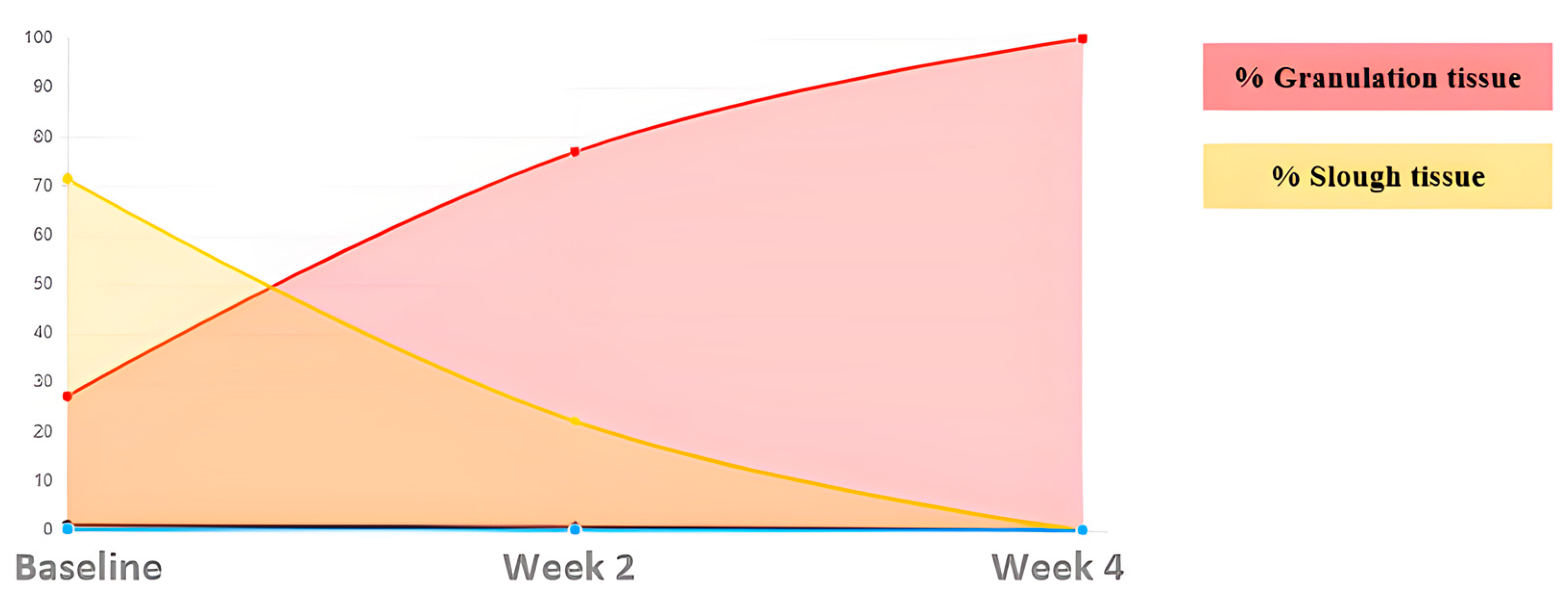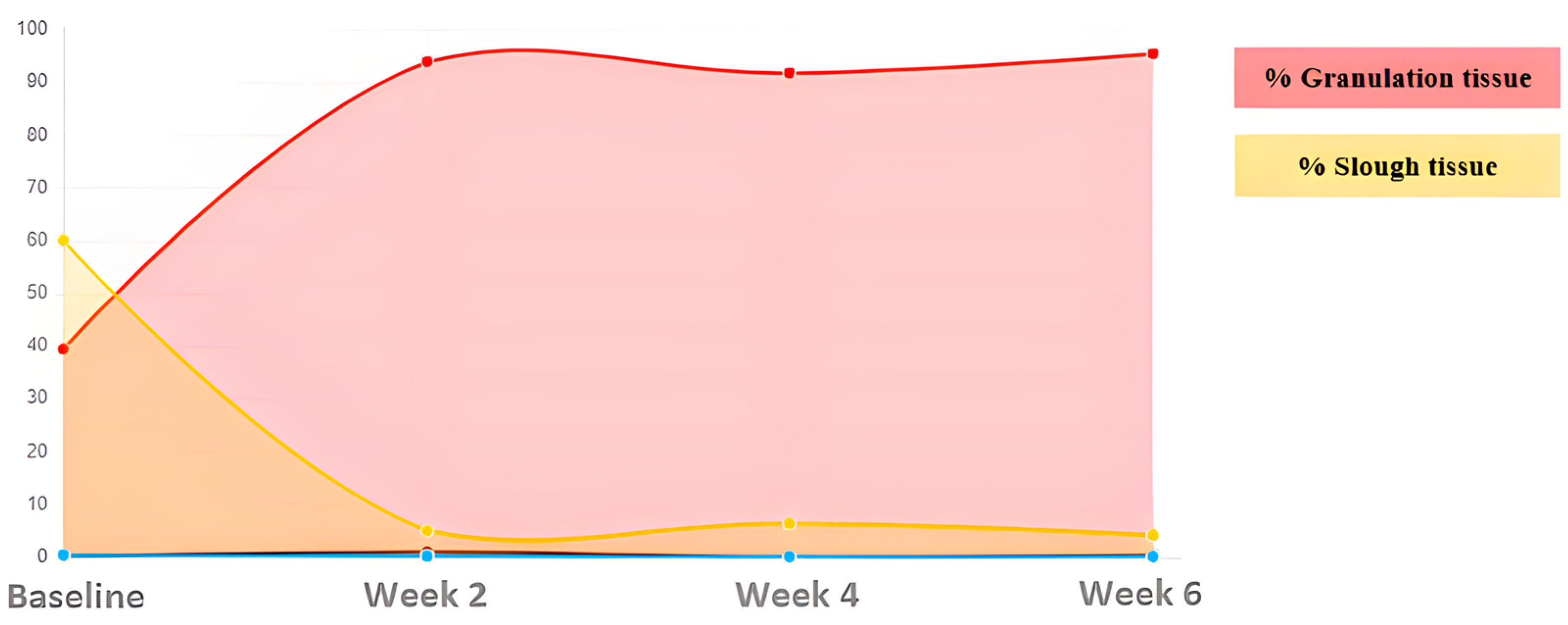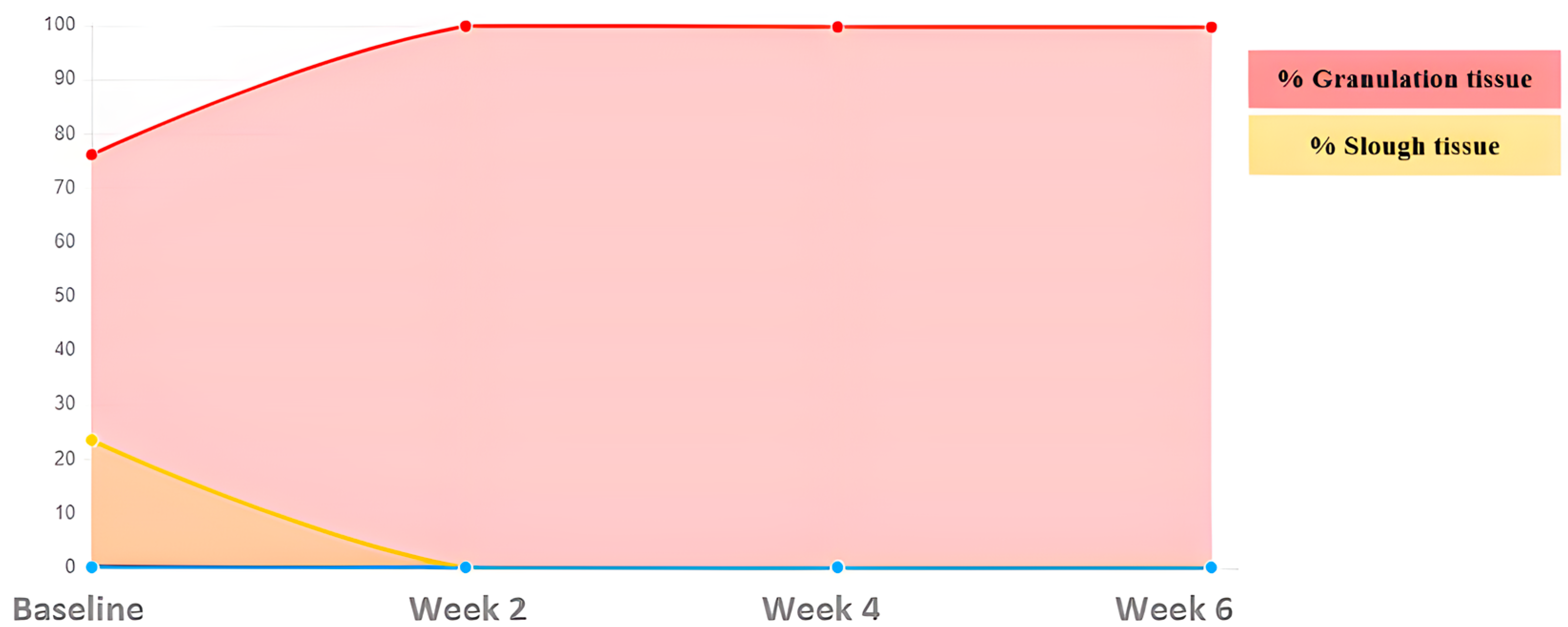A Digital Tool for Measuring Healing of Chronic Wounds Treated with an Antioxidant Dressing: A Case Series
Abstract
1. Introduction
2. Materials and Methods
2.1. Study Design
2.1.1. Wound Management
2.1.2. Statistical Analysis
2.1.3. Ethical Aspects
3. Results
3.1. Description of HELCOS Wound Healing Software
3.2. Description of Wounds
3.3. Healing Monitoring
4. Discussion
5. Conclusions
Author Contributions
Funding
Institutional Review Board Statement
Informed Consent Statement
Data Availability Statement
Acknowledgments
Conflicts of Interest
References
- Atkin, L.; Bućko, Z.; Conde Montero, E.; Cutting, K.; Moffatt, C.; Probst, A.; Romanelli, M.; Schultz, G.S.; Tettelbach, W. Im-plementing TIMERS: The race against hard-to-heal wounds. J. Wound Care 2019, 23, S1–S50. [Google Scholar] [CrossRef]
- Guo, S.; Di Pietro, L.A. Factors affecting wound healing. J. Dent. Res. 2010, 89, 219–229. [Google Scholar] [CrossRef] [PubMed]
- Jørgensen, L.B.; Sørensen, J.A.; Jemec, G.B.; Yderstraede, K.B. Methods to assess area and volume of wounds—A systematic review. Int. Wound J. 2016, 13, 540–553. [Google Scholar] [CrossRef]
- Verdú Soriano, J.; López Casanova, P.; Rodríguez Palma, M.; García Fernández, F.P.; Pancorbo Hidalgo, P.L.; Soldevilla Ágreda, J.J. HELCOS. Sistema integrado para el manejo de heridas. Rev. ROL Enferm. 2018, 41, 778–783. [Google Scholar]
- Schilrreff, P.; Alexiev, U. Chronic inflammation in non-healing skin wounds and promising natural bioactive compounds treatment. Int. J. Mol. Sci. 2022, 23, 4928. [Google Scholar] [CrossRef] [PubMed]
- Beckman, K.B.; Ames, B.N. The free radical theory of aging matures. Physiol. Rev. 1998, 78, 547–581. [Google Scholar] [CrossRef]
- Rodriguez, P.G.; Felix, F.N.; Woodley, D.T.; Shim, E.K. The role of oxygen in wound healing: A review of the literature. Dermatol. Surg. 2008, 34, 1159–1169. [Google Scholar] [CrossRef]
- Cano, S.M.; Lancel, S.; Boulanger, E.; Neviere, R. Targeting Oxidative Stress and Mitochondrial Dysfunction in the Treat-ment of Impaired Wound Healing: A Systematic Review. Antioxidants 2018, 7, 98. [Google Scholar] [CrossRef] [PubMed]
- Ponugoti, B.; Xu, F.; Zhang, C.; Tian, C.; Pacios, S.; Graves, D.T. FOXO1 promotes wound healing through the up-regulation of TGF-beta1 and prevention of oxidative stress. J. Cell Biol. 2013, 203, 327–343. [Google Scholar] [CrossRef] [PubMed]
- Comino-Sanz, I.M.; López-Franco, M.D.; Castro, B.; Pancorbo-Hidalgo, P.L. The Role of Antioxidants on Wound Healing: A Review of the Current Evidence. J. Clin. Med. 2021, 10, 3558. [Google Scholar] [CrossRef]
- Liu, E.; Gao, H.; Zhao, Y.; Pang, Y.; Yao, Y.; Yang, Z.; Zhang, X.; Wang, Y.; Yang, S.; Ma, X.; et al. The potential application of natural products in cutaneous wound healing: A review of preclinical evidence. Front. Pharmacol. 2022, 13, 9004339. [Google Scholar] [CrossRef] [PubMed]
- Reoxcare. Available online: https://www.reoxcare.com/ (accessed on 30 November 2022).
- Castro, B.; Palomares, T.; Azcoitia, I.; Bastida, F.; del Olmo, M.; Soldevilla, J.J.; Alonso-Varona, A. Development and preclin-ical evaluation of a new galactomannan-based dressing with antioxidant properties for wound healing. Histol. Histopathol. 2015, 30, 1499–1512. [Google Scholar] [CrossRef]
- Alven, S.; Nqoro, X.; Aderibigbe, B.A. Polymer-Based Materials Loaded with Curcumin for Wound Healing Applications. Polymers 2020, 12, 2286. [Google Scholar] [CrossRef] [PubMed]
- Ozkaya, H.; Omma, T.; Bag, Y.M.; Uzunoglu, K.; Isildak, M.; Duymus, M.E.; Kismet, K.; Senes, M.; Fidanci, V.; Celepli, P.; et al. Topical and Systemic Effects of N-acetyl Cysteine on Wound Healing in a Diabetic Rat Model. Wounds 2019, 31, 91–96. [Google Scholar] [PubMed]
- Castro, B.; Bastida, F.D.; Segovia, T.; López Casanova, P.; Soldevilla, J.J.; Verdú-Soriano, J. The use of an antioxidant dressing on hard-to-heal wounds: A multicentre, prospective case series. J. Wound Care 2017, 26, 742–750. [Google Scholar] [CrossRef] [PubMed]
- Jiménez-García, J.F.; Aguilera-Manrique, G.; Parra-Anguita, L.; Torra-Bou, J.E.; Villegas-Tripiana, I.; García-Fernández, F.P. An antioxidant approach directed to non-healing wounds activation-A case report study. Clin. Case Rep. Rev. 2021, 7, 1–6. [Google Scholar] [CrossRef]
- Comino-Sanz, I.M.; López-Franco, M.D.; Castro, B.; Pancorbo-Hidalgo, P.L. Antioxidant dressing therapy versus standard wound care in chronic wounds (the REOX study): Study protocol for a randomized controlled trial. Trials 2020, 8, 505. [Google Scholar] [CrossRef]
- Kundin, J. A new way to size up a wound. Am. J. Nurs. 1989, 89, 206–207. [Google Scholar]
- Restrepo-Medrano, J.C.; Verdú Soriano, J. Development of a wound healing index for chronic wounds. EWMA J. 2012, 12, 39–46. [Google Scholar]
- Flanagan, M. Wound measurement: Can it help us to monitor progression to healing? J. Wound Care 2003, 12, 189–194. [Google Scholar] [CrossRef]
- HELCOS. Integrated Wound Management System. 2017. Available online: https://helcos.net (accessed on 30 November 2022).
- Chang, A.C.; Dearman, B.; Greenwood, J.E. A comparison of wound area measurement techniques: Visitrak versus photography. Eplasty 2011, 11, e18. [Google Scholar] [PubMed]












| Wound Characteristics | Mean (Standard Deviation) |
|---|---|
| Length in cm | 4.75 (3.45) |
| Width in cm | 2.86 (1.75) |
| Area in cm2 | 13.46 (16.88) |
| Area in cm2 ** | 5.64 (17.58) |
| Granulation tissue % | 34.05 (25.46) |
| Devitalized tissue % | 64.82 (42.69) |
| RESVECH 2.0 total score | 15.79 (4.73) |
| ASSESMENT | % Granulation | % Slough | Area (cm2) |
|---|---|---|---|
| Baseline | 27.24 | 72.74 | 5.86 |
| Week 2 | 76.99 | 23.01 | 3.74 |
| Week 4 | 100 | 0 | 3.44 |
| Week 6 | 27.24 | 72.74 | 5.86 |
| Week 8 | COMPLETE HEALING | ||
| ASSESMENT | % Granulation | % Slough | Area (cm2) |
|---|---|---|---|
| Baseline | 10.02 | 89.98 | 4.73 |
| Week 2 | 41.1 | 50.73 | 1.49 |
| Week 4 | 71.77 | 28.02 | 0.36 |
| Week 6 | 69.17 | 30.83 | 0.68 |
| Week 8 | COMPLETE HEALING | ||
| ASSESMENT | % Granulation | % Slough | Area (cm2) |
|---|---|---|---|
| Baseline | 31.1 | 68.9 | 27.41 |
| Week 2 | 6.4 | 92.84 | 27.95 |
| Week 4 | 84.24 | 13.92 | 21.56 |
| Week 6 | 83.95 | 16.04 | 21.30 |
| Week 8 | 91.57 | 8.46 | 13.88 |
Disclaimer/Publisher’s Note: The statements, opinions and data contained in all publications are solely those of the individual author(s) and contributor(s) and not of MDPI and/or the editor(s). MDPI and/or the editor(s) disclaim responsibility for any injury to people or property resulting from any ideas, methods, instructions or products referred to in the content. |
© 2023 by the authors. Licensee MDPI, Basel, Switzerland. This article is an open access article distributed under the terms and conditions of the Creative Commons Attribution (CC BY) license (https://creativecommons.org/licenses/by/4.0/).
Share and Cite
Comino-Sanz, I.M.; Cabello Jaime, R.; Arboledas Bellón, J.; Jiménez-García, J.F.; Muñoz-Conde, M.; Díez Requena, M.J.; Díaz, F.J.G.; Castro, B.; Pancorbo-Hidalgo, P.L. A Digital Tool for Measuring Healing of Chronic Wounds Treated with an Antioxidant Dressing: A Case Series. Int. J. Environ. Res. Public Health 2023, 20, 4147. https://doi.org/10.3390/ijerph20054147
Comino-Sanz IM, Cabello Jaime R, Arboledas Bellón J, Jiménez-García JF, Muñoz-Conde M, Díez Requena MJ, Díaz FJG, Castro B, Pancorbo-Hidalgo PL. A Digital Tool for Measuring Healing of Chronic Wounds Treated with an Antioxidant Dressing: A Case Series. International Journal of Environmental Research and Public Health. 2023; 20(5):4147. https://doi.org/10.3390/ijerph20054147
Chicago/Turabian StyleComino-Sanz, Inés María, Rafael Cabello Jaime, Josefina Arboledas Bellón, Juan Francisco Jiménez-García, Mercedes Muñoz-Conde, María José Díez Requena, Francisco Javier García Díaz, Begoña Castro, and Pedro Luis Pancorbo-Hidalgo. 2023. "A Digital Tool for Measuring Healing of Chronic Wounds Treated with an Antioxidant Dressing: A Case Series" International Journal of Environmental Research and Public Health 20, no. 5: 4147. https://doi.org/10.3390/ijerph20054147
APA StyleComino-Sanz, I. M., Cabello Jaime, R., Arboledas Bellón, J., Jiménez-García, J. F., Muñoz-Conde, M., Díez Requena, M. J., Díaz, F. J. G., Castro, B., & Pancorbo-Hidalgo, P. L. (2023). A Digital Tool for Measuring Healing of Chronic Wounds Treated with an Antioxidant Dressing: A Case Series. International Journal of Environmental Research and Public Health, 20(5), 4147. https://doi.org/10.3390/ijerph20054147







